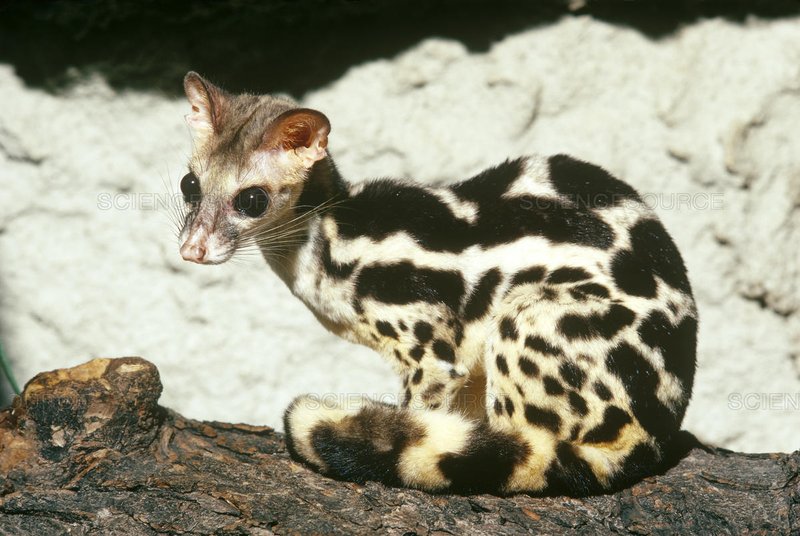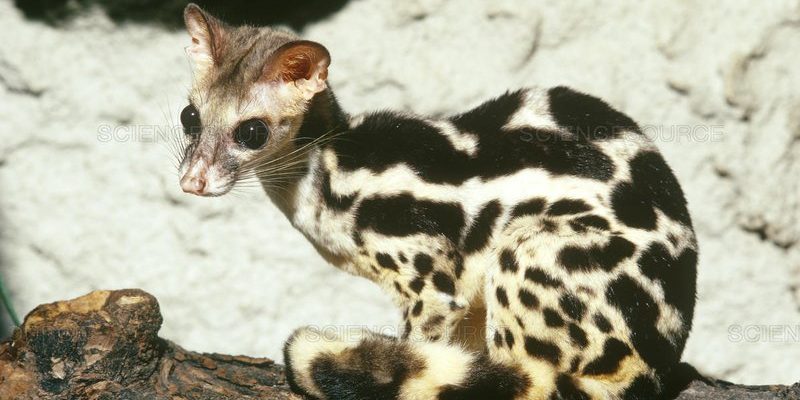
You might not have heard of a linsang before, and that’s perfectly okay! These intriguing mammals belong to the family of civets and are found mostly in Southeast Asia and parts of Africa. Think of them as somewhat of a mystery wrapped in fur. Linsangs are not only unique in their appearance but also in their behavior. They are nocturnal, which means they thrive in the dark. If you’ve ever stayed up late waiting for the sun to rise, you can relate to their lifestyle!
With their slender bodies, sharp claws, and long tails, linsangs may resemble cats at first glance, but they are quite different. They are agile climbers and often hunt in trees. Imagine a furry acrobat swinging from branch to branch, gracefully navigating its way through the foliage. You’ll often find them hunting small mammals, birds, and insects. So, if you’re ever in their neck of the woods, don’t be surprised if you catch a glimpse of these agile foragers going about their nightly adventures.
Physical Characteristics
Linsangs come in two main species: the African linsang and the Asian linsang, each with distinct features. They share some common traits, of course! On average, linsangs measure around 18 to 28 inches long, excluding their tails, which can be just as long, if not longer. This elongated body assists them in their climbing and hunting habits. Picture them darting through trees with the agility of a gymnast—it’s quite the sight!
Their fur is typically a mix of yellowish to brown with striking dark spots. This coloration serves a purpose: it helps them blend into their forest surroundings, providing them with the perfect camouflage against potential predators. This natural design is like nature’s way of giving them a stylish outfit while keeping them safe. You can’t help but admire how well they’ve adapted to their environment!
But there’s more! Linsangs have retractable claws, a feature reminiscent of their feline relatives. This retractable mechanism allows for both stealth when stalking prey and protection when they’re not in use. Their sharp teeth and strong jaws are perfect for capturing and consuming small prey, making them effective hunters. Talk about a complete package for survival!
Habitat and Distribution
Linsangs primarily inhabit tropical forests and woodlands. You’ll find them in areas rich in biodiversity, where they can find plenty of food to sustain their active lifestyles. These habitats provide the trees they need for climbing and hunting and the cover they require to avoid predators. Imagine living in a vibrant jungle where every day feels like an adventure!
The African linsang, as the name suggests, is mainly found across various parts of Africa, including countries like Cameroon and Uganda. Conversely, the Asian linsang roams through regions like Thailand, Malaysia, and Indonesia. It’s fascinating how these two species thrive in such different environments while sharing similar traits. You might be wondering how they manage to adapt to their specific habitats. Their flexibility in hunting and ability to climb high into the trees play a key role!
The geographical distribution of linsangs highlights the importance of forest conservation. As human activity continues to encroach on their habitats, the future of these amazing creatures hangs in the balance. By protecting their natural environment, we not only safeguard linsangs but also the countless other species that share their home. It’s a reminder that every creature, no matter how small, plays a role in our ecosystem.
Diet and Hunting Behavior
Linsangs are carnivorous, which means their diet consists mainly of meat. Picture a late-night snack hunt, where they scavenge the trees and forest floor for a variety of small prey. Their diet includes rodents, birds, insects, and even small reptiles. This variety means they need to be versatile hunters, adjusting their tactics based on what’s available. It’s like being a gourmet chef, but instead of cooking, they’re constantly searching for the freshest ingredients!
Hunting is not just about catching food; it’s also a display of their agility and skills. They often stalk their prey in silence, using their keen sense of smell and night vision to locate a meal. When the moment is right, they pounce with impressive speed. This technique is astonishing to witness and reveals the natural instincts that allow them to thrive in the wild. Think of it as a miniversion of a fast-paced action movie—only this time, the star is a linsang!
Another interesting aspect of their diet is their ability to adapt to seasonal changes. During certain times of the year, when small mammals may be less available, they can switch their focus to insects or fruits. This adaptability shows how they are finely tuned to their surroundings, ensuring their survival amid changing conditions. So, whether they’re savoring a crispy cricket or a juicy rodent, linsangs make the most of what nature offers.
Reproduction and Lifecycle
When it comes to reproduction, linsangs aren’t just about food and survival; they are also dedicated parents. The breeding season generally occurs once a year, with females giving birth to a small litter of 1 to 4 kits. After about 2 to 3 months of gestation, the little ones are born blind and helpless, relying entirely on their mother for care. Picture a cozy scene, with a mother linsang snuggled up with her newborns, providing warmth and protection as they grow.
As the kits develop, they gradually learn the skills necessary for survival. Within a few months, they start venturing out of the nest and exploring their surroundings. This is when the fun begins! They engage in playful behavior, honing their climbing and hunting skills under the watchful gaze of their mother. You can imagine the joy as they frolic about, building their confidence and independence.
By the time they are around six months old, these young linsangs are often ready to venture out on their own. They will find their own territories and establish their own hunting grounds. It’s a fascinating transition from adorable kits to independent hunters—much like our own journeys into adulthood! Each linsang that successfully separates from its mother adds to the population, ensuring that their unique species continues to thrive.
Conservation Status
While linsangs are remarkable creatures, they face numerous threats that challenge their survival. Habitat destruction, primarily due to deforestation and human encroachment, poses a significant risk. As forests are cleared for agriculture or urban development, linsangs lose their homes and food sources. This alarming trend affects their populations and the overall health of the ecosystem they inhabit.
Additionally, poaching and the illegal wildlife trade put further pressure on linsangs. Their fur and unique appearance make them targets for both hunters and collectors. As demand increases, linsangs find themselves in a precarious position, struggling to thrive in an environment that is becoming less hospitable. It’s like gradually pulling the rug out from under them—definitely not a fair situation!
Conservation organizations are working tirelessly to protect these fascinating animals and their habitats. Efforts range from raising awareness about the threats they face to implementing laws that safeguard their natural environments. By supporting these initiatives, you can play a role in preserving not just linsangs but the rich biodiversity they represent. Every little bit helps; it’s a team effort, and every action counts!
Interesting Facts About Linsangs
| Species: | African Linsang, Asian Linsang |
| Size: | 18 to 28 inches (not including tail) |
| Weight: | 4 to 11 pounds |
| Habitat: | Tropical forests and woodlands |
| Diet: | Carnivorous – small mammals, birds, insects |
| Lifespan: | Up to 10 years in the wild |
FAQ
What does a linsang look like?
Linsangs are slender, agile mammals with elongated bodies and long tails. They typically have fur that ranges from yellowish to brown, featuring dark spots that help them camouflage in their forest habitats. Their retractable claws and sharp teeth make them effective hunters, and they have a similar appearance to cats, although they belong to a different family.
Where can I find linsangs in the wild?
You can find linsangs in tropical forests and woodlands in Southeast Asia and parts of Africa. The African linsang is commonly found in regions like Cameroon and Uganda, while the Asian linsang roams through countries such as Thailand, Malaysia, and Indonesia. These environments provide the habitat and food sources they need to thrive.
Are linsangs endangered?
While linsangs are not currently classified as endangered, they face threats such as habitat loss due to deforestation and poaching. These factors can significantly impact their populations and their chance of survival in the wild. Conservation efforts are crucial to protect these unique animals and their habitats.
How do linsangs hunt their prey?
Linsangs are skilled hunters that primarily hunt at night. They utilize their keen sense of smell and night vision to locate prey like small mammals, birds, and insects. Their agility allows them to stealthily stalk and pounce on their prey, making them highly effective hunters in the forest.
What do linsangs eat?
Linsangs are carnivorous creatures, meaning they primarily feast on meat. Their diet includes a variety of small animals such as rodents, birds, and insects. They are adaptable eaters, often switching their focus based on seasonal availability of food in their habitat.
How long do linsangs live in the wild?
In the wild, linsangs can live up to 10 years, depending on their environment and the threats they face. Factors such as food availability, habitat conditions, and predation play crucial roles in their lifespan. In protected environments like zoos, they may live longer due to better care and lack of natural predators.
What threats do linsangs face in their natural habitat?
Linsangs face several threats, primarily habitat loss due to deforestation and encroachment by human activities. Additionally, poaching and the illegal wildlife trade put pressure on their populations. As these threats continue, it’s vital to support conservation efforts aimed at protecting them and their habitats.
Can linsangs be kept as pets?
While linsangs are fascinating creatures, they are not suitable as pets due to their complex needs and wild nature. They require specific diets, environments, and social structures that are difficult to replicate in a domestic setting. It’s essential to respect their wild nature and support their conservation in the wild instead.
How do linsangs care for their young?
Female linsangs are dedicated mothers, nurturing their young from birth. After a gestation period of about 2 to 3 months, the young are born blind and vulnerable. The mother takes care of them, providing warmth and protection until they are ready to explore and learn essential survival skills. This nurturing phase is crucial for their development.
Are linsangs solitary or social animals?
Linsangs are generally solitary creatures, preferring to hunt and live alone, except during the breeding season or when rearing young. This solitary lifestyle suits their hunting strategies, allowing them to establish and protect territories without competition from others. However, they may occasionally be seen interacting with others, especially in overlapping territories.
What can I do to help protect linsangs?
You can help protect linsangs by supporting conservation organizations that work to preserve their habitats and wildlife. Educating yourself and others about the importance of biodiversity and the threats these animals face is also vital. Finally, advocating for sustainable practices in your community can contribute to habitat conservation efforts that will benefit not just linsangs but many other species as well.

